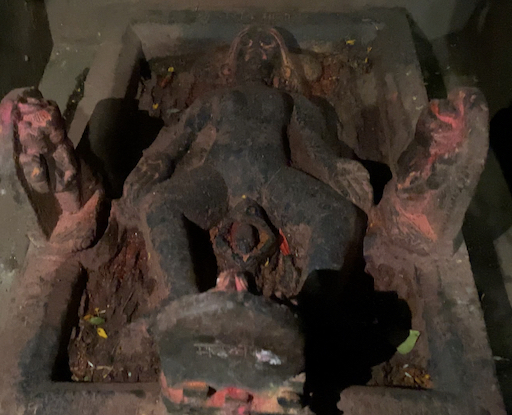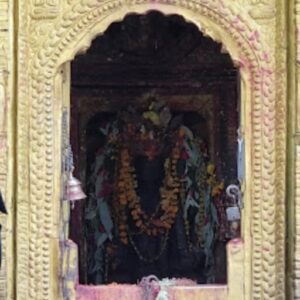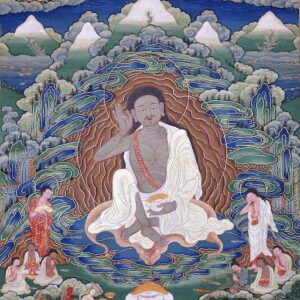This is a temple of Bagh Bhairab. There is a place to sit and meditate. You can go into meditative states here effortlessly.
How to Get there
It is located in the center of Kirtipur.
Map: https://goo.gl/maps/4YSFRDRNRqQqFLtB8
About Bagh Bhairab
Origin of the Deity’s Image
Popular legend holds that the image of the deity manifested itself long ago, either when a bored shepherd (per Dowman) or a group of shepherd girls (per Shrestha) fashioned a makeshift tiger image out of clay (or burrs). To complete the likeness, they set off in search of a poinsettia leaf use as its tongue, but when they returned, they discovered that their sheep were missing and the mouth of their “tiger” was filled with blood. As this indicated that Bhairab had taken refuge in the idol (and consumed the sheep), the image was moved to the present temple and kept as an object of veneration. However, as punishment for eating the sheep, the girls (or the shepherd) refused to affix the tongue to the image, and to this day, the idol is represented with a wide, open mouth, sans tongue.
This image of Bhairab in Kirtipur is particular to this location. It should not be confused with other manifestations of Bhairab, such as the Akas Bhairab (sky Bhairab) in Bhaktapur, or other Bhairab temples in Lalitpur (Patan), Kathmandu, and elsewhere.
Dowman notes that Kiritipur’s Bhairab claims Newar farmers (Jyapus) as his main devotees, though the god is worshiped widely as a fearsome protector of Kirtipur as a whole. Evidence of his terrifying nature and his role as guardian can be found on the front (south) facade of the temple, where many dozens of terrible knives, swords, and other weaponry are nailed to the wall. There is some ambiguity regarding their origin. Dowman notes that they were captured from Gorkhali attackers during a siege of the city in the late 18th century, while Hutt mentions that Kirtipur’s Newar defenders surrendered them. Adjacent to the weaponry is a helmet thought to belong to Kalu Pande, the commander of the unsuccessful 1757 invasion. Although the Gorkhalis eventually broke through Kirtipur’s defenses by 1768—resulting in the wholesale amputation of civilian noses and ears as punishment—the defenders fought bravely; they were only forced to surrender when one of the key defenders of nearby Lalitpur switched sides.
Bagh Bhairab Temple (early 16th century onward in present form) (Nepali: बाघ भैरव मन्दिर)
The Bagh Bhairab temple is located near the center of the peanut-shaped hill that defines Kirtipur and forms the beating heart of the district’s religious community. It is the only temple in the Kathmandu valley dedicated to the “Tiger” form of Bhairav, which is manifested in the form of a small clay tiger that is remade every 15-25 years as the old image grows fragile. Although the site is most notable for its massive three-story temple tower (rectangular, like all Bhairav temples), its grounds house numerous smaller shrines housing various images, some dating back to as early as the 3rd-4th centuries.
The age of the temple is not known with any certainty. According to Shrestha, the site’s oldest inscription dates to 1503 and is found on the Mana Binayak shrine in the temple’s front courtyard. Hutt notes that the main building was clearly present in something like its current form as early as 1515, as records indicate a restoration in that period. He also notes that the temple’s founding may extend back to the reign of King Shivadeva III (1099-1126), the founder of Kirtipur, but this remains to be supported by archaeological evidence (the single reference to this date is from a local chronicle).
The site comprises a roughly 30 x 50-meter quadrangle bounded by high walls. It is roughly aligned north-south but is canted somewhat to the east, aligned with the local topography. The main entrance is from the road to the south, while subsidiary buildings bound the site’s western edge. On the north and to the east, the temple’s vistas open up to a sweeping view of the Kathmandu valley and the central city. The unobstructed view from the east is important from a religious standpoint as a small hole in the east wall known as a dyo pvah allows a single ray of sunlight to glance upon the face of the deity each day.
Source
https://www.orientalarchitecture.com/sid/1488/nepal/kirtipur/bagh-bhairab-temple
This is a temple of Bagh Bhairab. There is a place to sit and meditate. You can go into meditative states here effortlessly.
How to Get there
It is located in the center of Kirtipur.
Map: https://goo.gl/maps/4YSFRDRNRqQqFLtB8
About Bagh Bhairab
Origin of the Deity’s Image
Popular legend holds that the image of the deity manifested itself long ago, either when a bored shepherd (per Dowman) or a group of shepherd girls (per Shrestha) fashioned a makeshift tiger image out of clay (or burrs). To complete the likeness, they set off in search of a poinsettia leaf use as its tongue, but when they returned, they discovered that their sheep were missing and the mouth of their “tiger” was filled with blood. As this indicated that Bhairab had taken refuge in the idol (and consumed the sheep), the image was moved to the present temple and kept as an object of veneration. However, as punishment for eating the sheep, the girls (or the shepherd) refused to affix the tongue to the image, and to this day, the idol is represented with a wide, open mouth, sans tongue.
This image of Bhairab in Kirtipur is particular to this location. It should not be confused with other manifestations of Bhairab, such as the Akas Bhairab (sky Bhairab) in Bhaktapur, or other Bhairab temples in Lalitpur (Patan), Kathmandu, and elsewhere.
Dowman notes that Kiritipur’s Bhairab claims Newar farmers (Jyapus) as his main devotees, though the god is worshiped widely as a fearsome protector of Kirtipur as a whole. Evidence of his terrifying nature and his role as guardian can be found on the front (south) facade of the temple, where many dozens of terrible knives, swords, and other weaponry are nailed to the wall. There is some ambiguity regarding their origin. Dowman notes that they were captured from Gorkhali attackers during a siege of the city in the late 18th century, while Hutt mentions that Kirtipur’s Newar defenders surrendered them. Adjacent to the weaponry is a helmet thought to belong to Kalu Pande, the commander of the unsuccessful 1757 invasion. Although the Gorkhalis eventually broke through Kirtipur’s defenses by 1768—resulting in the wholesale amputation of civilian noses and ears as punishment—the defenders fought bravely; they were only forced to surrender when one of the key defenders of nearby Lalitpur switched sides.
Bagh Bhairab Temple (early 16th century onward in present form) (Nepali: बाघ भैरव मन्दिर)
The Bagh Bhairab temple is located near the center of the peanut-shaped hill that defines Kirtipur and forms the beating heart of the district’s religious community. It is the only temple in the Kathmandu valley dedicated to the “Tiger” form of Bhairav, which is manifested in the form of a small clay tiger that is remade every 15-25 years as the old image grows fragile. Although the site is most notable for its massive three-story temple tower (rectangular, like all Bhairav temples), its grounds house numerous smaller shrines housing various images, some dating back to as early as the 3rd-4th centuries.
The age of the temple is not known with any certainty. According to Shrestha, the site’s oldest inscription dates to 1503 and is found on the Mana Binayak shrine in the temple’s front courtyard. Hutt notes that the main building was clearly present in something like its current form as early as 1515, as records indicate a restoration in that period. He also notes that the temple’s founding may extend back to the reign of King Shivadeva III (1099-1126), the founder of Kirtipur, but this remains to be supported by archaeological evidence (the single reference to this date is from a local chronicle).
The site comprises a roughly 30 x 50-meter quadrangle bounded by high walls. It is roughly aligned north-south but is canted somewhat to the east, aligned with the local topography. The main entrance is from the road to the south, while subsidiary buildings bound the site’s western edge. On the north and to the east, the temple’s vistas open up to a sweeping view of the Kathmandu valley and the central city. The unobstructed view from the east is important from a religious standpoint as a small hole in the east wall known as a dyo pvah allows a single ray of sunlight to glance upon the face of the deity each day.
Source
https://www.orientalarchitecture.com/sid/1488/nepal/kirtipur/bagh-bhairab-temple
This is a temple of Bagh Bhairab. There is a place to sit and meditate. You can go into meditative states here effortlessly.
How to Get there
It is located in the center of Kirtipur.
Map: https://goo.gl/maps/4YSFRDRNRqQqFLtB8
About Bagh Bhairab
Origin of the Deity’s Image
Popular legend holds that the image of the deity manifested itself long ago, either when a bored shepherd (per Dowman) or a group of shepherd girls (per Shrestha) fashioned a makeshift tiger image out of clay (or burrs). To complete the likeness, they set off in search of a poinsettia leaf use as its tongue, but when they returned, they discovered that their sheep were missing and the mouth of their “tiger” was filled with blood. As this indicated that Bhairab had taken refuge in the idol (and consumed the sheep), the image was moved to the present temple and kept as an object of veneration. However, as punishment for eating the sheep, the girls (or the shepherd) refused to affix the tongue to the image, and to this day, the idol is represented with a wide, open mouth, sans tongue.
This image of Bhairab in Kirtipur is particular to this location. It should not be confused with other manifestations of Bhairab, such as the Akas Bhairab (sky Bhairab) in Bhaktapur, or other Bhairab temples in Lalitpur (Patan), Kathmandu, and elsewhere.
Dowman notes that Kiritipur’s Bhairab claims Newar farmers (Jyapus) as his main devotees, though the god is worshiped widely as a fearsome protector of Kirtipur as a whole. Evidence of his terrifying nature and his role as guardian can be found on the front (south) facade of the temple, where many dozens of terrible knives, swords, and other weaponry are nailed to the wall. There is some ambiguity regarding their origin. Dowman notes that they were captured from Gorkhali attackers during a siege of the city in the late 18th century, while Hutt mentions that Kirtipur’s Newar defenders surrendered them. Adjacent to the weaponry is a helmet thought to belong to Kalu Pande, the commander of the unsuccessful 1757 invasion. Although the Gorkhalis eventually broke through Kirtipur’s defenses by 1768—resulting in the wholesale amputation of civilian noses and ears as punishment—the defenders fought bravely; they were only forced to surrender when one of the key defenders of nearby Lalitpur switched sides.
Bagh Bhairab Temple (early 16th century onward in present form) (Nepali: बाघ भैरव मन्दिर)
The Bagh Bhairab temple is located near the center of the peanut-shaped hill that defines Kirtipur and forms the beating heart of the district’s religious community. It is the only temple in the Kathmandu valley dedicated to the “Tiger” form of Bhairav, which is manifested in the form of a small clay tiger that is remade every 15-25 years as the old image grows fragile. Although the site is most notable for its massive three-story temple tower (rectangular, like all Bhairav temples), its grounds house numerous smaller shrines housing various images, some dating back to as early as the 3rd-4th centuries.
The age of the temple is not known with any certainty. According to Shrestha, the site’s oldest inscription dates to 1503 and is found on the Mana Binayak shrine in the temple’s front courtyard. Hutt notes that the main building was clearly present in something like its current form as early as 1515, as records indicate a restoration in that period. He also notes that the temple’s founding may extend back to the reign of King Shivadeva III (1099-1126), the founder of Kirtipur, but this remains to be supported by archaeological evidence (the single reference to this date is from a local chronicle).
The site comprises a roughly 30 x 50-meter quadrangle bounded by high walls. It is roughly aligned north-south but is canted somewhat to the east, aligned with the local topography. The main entrance is from the road to the south, while subsidiary buildings bound the site’s western edge. On the north and to the east, the temple’s vistas open up to a sweeping view of the Kathmandu valley and the central city. The unobstructed view from the east is important from a religious standpoint as a small hole in the east wall known as a dyo pvah allows a single ray of sunlight to glance upon the face of the deity each day.
Source
https://www.orientalarchitecture.com/sid/1488/nepal/kirtipur/bagh-bhairab-temple




